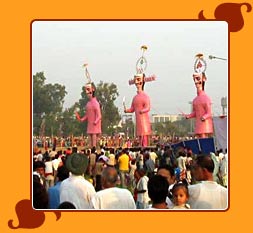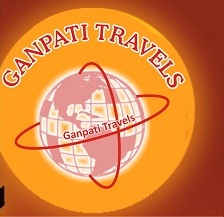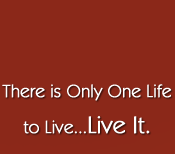In the months of Ashwin and Kartik, Hindus
observe a 10 day ceremony of fast, rituals, celebrations, fiests to honor
the mother Goddess and triumph of Lord Rama over Demon Ravana. Dussehra also
symbolizes the triumph of warrior Goddess Durga over the buffalo demon,
Mahishasura. Thus, it is a celebration of victory of good over evil.

This
celebration starts from Navratri and ends with the tenth day festival of “Dussehra”.
Navratri and Dussehra is celebrated throughout the country at the same time,
with varying rituals, but with great enthusiasm and energy as it marks the
end of scorching summer and the start of winter season. The tenth day after
Navratri is called Dussehra, on which number of fairs are organized
throughout the northern India, burning effigies of Ravana.It is also called
“Vijayadashmi” as this day marks the victory of Lord Rama over
Ravana.
VijayaDashami is considered to be an
auspicious day for the Indian householder, on which he worships, protects
and preserves 'Shakti' (power). According to Scriptures, by worshipping the
'Shakti' on these nine-days the householders attain the threefold power i.e.
physical, mental and spiritual, which helps him to progress in life without
any difficulty. The 'Ramlila' - an enactment of the life of Lord Rama, is
held during the nine days preceding Dussehra. On the tenth day (Dussehra or
Vijay Dasami), larger than life effigies of Ravana, his son and brother -
Meghnadh and Kumbhakarna are set to fire.
The theatrical enactment
of this dramatic encounter is held throughout the country in which every
section of people participates enthusiastically. In burning the effigies the
people are asked to burn the evil within them, and thus follow the path of
truth and goodness, bearing in mind the instance of Ravana, who despite all
his might and majesty was destroyed for his evil ways.
The
Exciting Tales Associated With The Festival This hugely popular
festival falls on the 10th day of the waxing moon during the Hindu month of
Ashvin (around September or October). A fascinating collection of
mythological legends and regional tales are embroidered around Dussehra. On
this day, Rama, the god-king and hero of the great Hindu epic, Ramayana,
killed the unrighteous Ravana, the 10-headed demon king of Lanka who had
abducted Rama’s wife, Sita. It is believed that Lord Rama’s
brother Lakshmana, along with an army of monkeys, fought a colossal battle
that lasted 10 days. Rama, who was a devout believer of Durga, the Goddess
of War, prayed to her for the first nine days of battle and killed the evil
Ravana on the 10th day.
He shot Ravana with a bow that pierced his
navel. Out flowed the nectar of immortality that was stored in a pot in his
navel, thus destroying his invincibility. Ravana’s own brother
Vibhishana (being the sensible one, he had switched sides) had divulged this
secret to Rama. Rama also slew Ravana’s brother Kumbhkarna (more famous
for maintaining a lifestyle worthy of a record in the Guinness Book –
he hibernated for six months at a stretch each year!). Lakshmana killed
Ravana’s son, Meghnath. and Dussehra is the festival that commemorates
this triumph of Good over Evil. To this day Rama Lila (the enactment of the
Ramayana, or literally the saga of Rama) is staged in towns and villages
across the length and breadth of the country.
Delhi
Ramlila Ground --A Famous Site For Ramlila Lovers Perhaps the most
celebrated Ram Lila is the one held in Old Delhi around the Red Fort. This
Ram Lila in particular is of considerable social and religious significance.
The more important actors and actresses for this Ram Lila come from a small
town in Uttar Pradesh called Moradabad. The man who plays Rama has been
doing so for the past 15 years or so.
The organisers of the Rama
Lila host his stay and he describes this experience as an essentially
purifying one. He is expected to remain celibate, abstain from smoking and
drinking and other such practices for the month that he spends in Old Delhi.
He is subject to such veneration and awe by people that when he walks in the
streets, people come out of their homes to touch his feet. He says that he
feels it incumbent upon him to live upto this reverence and to not do
anything that would go against the grain of the adulation that people bestow
upon him.
He also says that the experience has added meaning to
his life and helped him become a better person. Such is the importance of
this Rama Lila that it is almost a ritual for the Prime Minister or the
President of India to attend it. The Prime Minister of India, Mr. Atal
Bihari Vajpayee, attended the Ram Lila held in 1999.
The
Blazing of Ravana After the Ram Lila and the burning of the
effigies of Ravana, Kumbhakarna and Meghnath (right down to their curly
moustaches), the stars of the night – Rama, Sita and Lakshmana are
taken around in a huge chariot. Crowds of people shouting Jai Shri Ram
(Victory to Rama) join the procession. (The processions of Mysore in
Karnataka, and Ahmedabad in Gujarat are especially spectacular). The stars
are driven right up to their doorsteps, and India wakes up to a new day and
the business of making a living. In a small town in Uttar Pradesh, Rama goes
to work like the rest of us. But come September and he will again be god.






